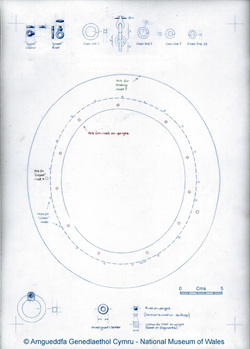Iron Age Crown or Bowl?
BackgroundIn 2007, during preparations for the Origins archaeology display in National Museum Wales, curatorial staff commissioned a crafted interpretation of an object now referred to as the Cerrigydrudion crown.
The crown was discovered in 1924 within a small, stone-lined chamber. Little information exists about the relative positions of some of its pieces. No human remains survived. It has been variously interpreted as a bowl, lid or head-piece (as here) but is, in any case, an important example of Early Iron Age 'La Tène' art. As an exhibit, it is too often overlooked due to its fragmentary and obscure appearance. It was thought that a 'reconstructed' display-object might promote discussion and attract attention to this extraordinary artefact. |
The projectMy task was to create an interpretation of the engraved design and provide detailed plans of how components might fit together for the commissioned craftsman - the late Nodge Nolan.
My objective here is to display a small selection of the 25 (or more) plans which I created for Nodge to use throughout the commission. The project ran for several months whilst I and my colleagues fulfilled additional commitments for the Origins exhibition and other, scheduled work. It was a pleasure working with the curator, conservator and Nodge Nolan himself on such a unique object. |
The patternThe crown consists of around twenty or so larger pieces of thin, copper-alloy in fragmentary sheets of no more that .8 mm thickness. Around fifteen of these are decorated with engraved designs of palmettes, lotus petals and curvilinear 'tendrils'.
Most of these fragments can be interpreted as parts of a single brim or rim with some notably curved pieces forming the edge of a domed shape. There are also lengths of chain, a loop (with decorated attachment), pieces of rawhide (with at least one rivet hole through) and other smaller, metal fragments. |
Working at distanceNodge Nolan was based in Essex, whilst the other members of our project team were necessarily based at National Museum Wales. We were able to meet with Nodge only three times during the task in hand: once at the project's inception, once to view sample work and then lastly at handover.
This meant that I had to communicate a large amount of detail using diagrams, sketches, photographs and doodles. Having to produce a real object at the end provides an excellent focus for answering questions of form and function - some of which may have been answered better than others. |
The 'skullcap'The curved edge of the 'domed' piece suggests an original diameter of around 16 cms.
Exploring archive photographs revealed that there had been more metal when the crown was discovered than exists now. The edge has been offset or countersunk slightly, presumably in order to receive the material to which it was once riveted. There are rivets on the 'upper' flange of the 'brim' too but the disparate diameters of brim and skullcap would suggest some intervening material bridged the gap (making the assumption, as ever, that all parts came from a single object). |
Riveting storyThe brim is raised into an 'upper flange' with rivets going through it's vertical surface. There is also a 'lower flange' made of an oval piece of metal with an 'L' shaped cross-section (attached underneath the brim on the un-decorated side). This has been riveted to the brim and the decoration applied over it - 'hidden rivets'.
Some rivets appear to be replacements and have been less carefully made. |
Practical solutionsThe completed pattern contains all the elements available from the object itself plus extra details I took from archive photographs which show that the crown has suffered some material loss since 1924.
Gaps have been filled by repeating existing elements and by using parallels, particularly a Bronze flagon from Besançon. This digital version was produced for the engraver, James Pitt to use. I had to use a mirrored version of my own work for speed, but please note that it is still not symmetrical either vertically or horizontally. |








